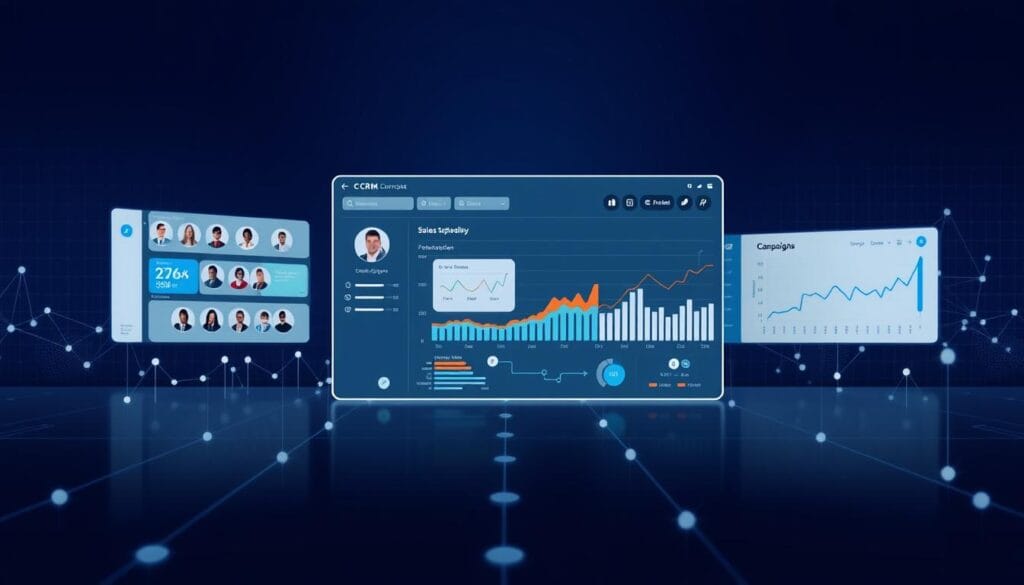29% more sales and 42% better forecast accuracy: those are not promises — they are measured outcomes when smart systems replace scattered tools.
We see high-ticket brands lose revenue to fractured systems every day. When contact records, emails, and purchase histories live in separate silos, opportunities for upsell and cross-sell vanish.
We offer a practical, ROI-first blueprint that turns that chaos into predictable expansion. This guide lays out how to centralize customer information, map each stage from awareness to advocacy, and unlock fast wins with repeatable plays.
Expect clear metrics, dashboard-ready actions, and playbooks that scale without bloat. Macro Webber partners with premium brands to engineer systems that compound revenue per customer and prove results in dollars and forecast accuracy.
Key Takeaways
- Centralize customer data to convert scattered signals into predictable revenue.
- Use a stage-based path from awareness to advocacy to multiply purchase value.
- Prioritize plays that lift sales and forecast accuracy first for quick ROI.
- Measure wins with dashboards and revenue models, not opinions.
- Partner with Macro Webber to execute disciplined steps and scale results.
The high-stakes challenge: Turn scattered customer data into scalable upsell and cross-sell
Siloed customer information quietly drains margins and chokes high-value deals. For premium businesses, gaps in records and mismatched outreach turn potential expansion into friction. We see longer decision times, duplicated work, and missed offers when information is fractured across tools.
Why it matters:
- Disconnected marketing, sales, and service records force teams to guess and delay action.
- Long consideration cycles for high-ticket purchases need precise stage tracking and synced timelines.
- Inconsistent messaging increases churn and wastes leads that should convert to upsell.
The hidden costs are real: manual list pulls, siloed campaigns, and escalations inflate operating expenses. Centralized timelines, synced email and calls, and unified access to interaction history eliminate those leaks. With clean data, businesses segment audiences for targeted campaigns and improve conversion rates.
“Every lost handoff is a lost deal — elite brands remove handoffs with one source of truth.”
We recommend a lifecycle-first operating model to compress time-to-value and protect premium positioning. This guide shows how to turn scattered signals into a growth engine that scales upsell and cross-sell predictably.
Understanding the customer lifecycle for revenue expansion
We start by treating the customer path as a set of loops, not a single line. Customers loop, skip, and re-enter, so our systems must recognize patterns rather than enforce rigid funnels.

We break the lifecycle into five practical stages: awareness, acquisition, conversion, retention, and advocacy. For each stage we define what the customer needs, what we deliver, and which signals show readiness to move forward.
Where to look and what to measure
- Map interactions: ad view → content consumption, demo request → decision call, onboarding → first success.
- Instrument key moments: form fills, proposal views, trial events, and NPS to surface actionable insights.
- Spot weak points: use stage-level data to find drop-offs and convert them into targeted tests.
We align sales and marketing around shared metrics so campaigns and conversations compound. Link retention signals—product adoption, support satisfaction, renewal behavior—to expansion so upsell reads like service, not a pitch.
“Design for patterns, not pipes — that’s how revenue scales.”
Measure stage-specific KPIs: awareness CTRs, acquisition-to-meeting rates, proposal acceptance, time-to-value in onboarding, and advocacy referrals. Then test, learn, and recalibrate continuously.
CRM & Client Lifecycle: how they work together to drive growth
A unified approach to contact records and compliance transforms onboarding from a bottleneck into a competitive asset.
We define the crm platform and crm system as the hub that centralizes contacts, timelines, tags, notes, and synced email and calls. That single source of truth sharpens marketing, tightens sales forecasting, and keeps customer service aligned across teams.
In regulated sectors, lifecycle orchestration extends the hub with compliance-grade workflows—AML/KYC checks, audit trails, and automated approvals. The result: faster onboarding, real-time risk signals, and verified personalization.
| Capability | Core System | Lifecycle Orchestration |
|---|---|---|
| Primary focus | Contact and interaction management | End-to-end stage governance and compliance |
| Key features | Timelines, tags, email/call sync, reporting | AML/KYC, audit logs, automated stage transitions |
| Outcome for brand | Better targeting, cleaner data, improved sales accuracy | Faster onboarding, lower risk, consistent experience |
Integration matters: combine both systems and you get fewer handoffs, standardized stage rules, and governance that preserves trust. That structure raises forecast accuracy and frees leaders to scale premium offers with confidence.

Build your data foundation: centralize, cleanse, and govern customer information
A disciplined data foundation eliminates guesswork and accelerates decision velocity across teams.
We centralize customer data and core information into one trusted system with ownership rules and naming standards.
Then we enable visibility: timelines, tags, notes, and standardized fields turn scattered signals into actionable insights.
Integrate email sync and call logging so every touch—sales, marketing, service—is captured automatically.
- Set data quality rules: required fields, validation, dedupe, and enrichment to prevent decay.
- Enforce role-based access and audit trails to protect privacy and retention goals.
- Blueprint automation: route leads, alert owners, and start onboarding once conditions are met.
| Capability | Features | Outcome |
|---|---|---|
| Contact management | Timelines, tags, notes | Full-funnel visibility for sales and service |
| Integrations | Email sync, call logging, calendar | No blind spots; faster response to leads |
| Governance | Access controls, validations, audit logs | Trusted data for forecasting and retention |
Measure results: higher sales productivity, fewer missed leads, and consistent experiences for customers.
Lifecycle playbooks: practical strategies to increase upsell and cross-sell
We map plays to signals so teams know exactly when to offer higher-margin options. These playbooks give high-ticket brands a sequence of tactics per stage so every outreach is timed and measurable.
Reach and Acquisition
Launch segmented marketing campaigns using personas and behavioral data. Align offers to intent and use gated assets or book-a-demo flows that qualify leads.
Set up multi-channel capture—website forms, event QR, social touchpoints, and live chat—to auto-route leads and trigger fast, personalized follow-ups.
Conversion
Provide real-time support at decision points: live chat, call-back, and knowledge bases. Simplify the purchase path with minimal fields and clear trust signals.
Surface well-timed complementary offers and use progressive profiling. Align sales sequences to engagement signals like proposal views or pricing page visits.
Retention
Automate post-purchase journeys: onboarding emails, training, and first-value milestones. Prompt reorders before depletion and create VIP tiers for high-value customers.
Link NPS and CSAT to service plays so positive feedback becomes case studies and upsell readiness.
Advocacy
Operationalize reviews and referral flows with one-click links and rewards. Celebrate advocates publicly to encourage repeat purchases and social proof.
Quick tactics summary
| Stage | Core Tactic | Immediate ROI |
|---|---|---|
| Reach | Segmented campaigns + gated demos | Higher lead quality; faster qualification |
| Conversion | Live support + frictionless purchase | Lower abandon rates; increased AOV |
| Retention | Automated onboarding + VIP perks | Improved repeat purchase; lower churn |
| Advocacy | One-click reviews & referral rewards | More referrals; amplified trust |
Activate automation and personalization across teams
When teams automate with intent, repeatable personalization scales without sounding robotic.
Sales automation for lead nurturing and pipeline health
We standardize pipeline stages and triggers so the sales team always knows the next best action.
Play-level tactics: sequence personal email cadences, surface stalls by stage, and flag deals with low advancement rates.
Marketing automation for audience segmentation, drip campaigns, and A/B testing
We enable marketing automation to segment by persona, value, and lifecycle stage. Drip campaigns educate, not spam.
Run A/B tests on creative and measure engagement to keep messaging premium and precise.
Service automation to deliver consistent support across the entire customer lifecycle
We script common answers, proactive check-ins, and renewal reminders so customer service is reliable at scale.
Automated handoffs enforce SLAs: instant alerts, task creation, and escalation if response times slip.
“Automate with governance: every workflow documented, tested, and audited to preserve brand trust.”
| Function | Core features | Immediate impact |
|---|---|---|
| Sales | Stage rules, sequences, templates | Faster progression; fewer stalled deals |
| Marketing | Segmentation, drip, A/B testing | Higher engagement; better-qualified leads |
| Service | Scripting, reminders, SLA alerts | Consistent support; improved retention |
We log all interactions and email within crm so personalization compounds and data integrity stays high. Then we report on reply rates, meeting set rates, and sales acceleration to prove impact.
Prove impact and reoptimize: analytics, forecasting, and ROI
Turn raw interactions into actionable insights that prove which plays move revenue.
We build a compact analytics stack: executive dashboards, stage-level reports, and campaign attribution tools. This stack ties sales performance to marketing spend and lets us quantify outcomes within weeks.
Sales and revenue dashboards
Sales and revenue dashboards: conversion rates, deal values, and forecast accuracy
Track conversion by stage, average deal value, win velocity, and forecast accuracy on one executive view. When we use crm platform features, forecasting uses historical data plus current pipeline to guide planning.
Marketing performance
Marketing performance: click-through, open rates, lead-to-sale conversion
Measure click-through and open rates, and connect campaigns to lead-to-sale conversion. Move budget to the campaigns that print revenue, not vanity metrics.
Attribution and iteration
Attribution and iterative optimization to maximize lifetime value
We run A/B tests, pricing experiments, and weekly reallocations based on insights. Monthly pipeline reviews, quarterly attribution audits, and biannual schema refreshes make optimization repeatable.
“Measure, iterate, and prove: every change must show net revenue impact.”
Conclusion
Close the loop on growth by making your data work as one coordinated engine.
We showed how the right crm, applied with discipline, converts customer relationship data into repeatable revenue across the entire customer lifecycle. When you use a single crm system and one source of information, teams cut friction and raise conversion, retention, and forecast accuracy.
Strategy becomes execution: marketing precision, sales rigor, and customer service all run from the same playbook. Features and workflows only matter when they compound outcomes—faster stages, cleaner handoffs, higher purchase acceptance, and happier customers.
Act now. Request Macro Webber’s Growth Blueprint or book a private consult to audit your stack, pinpoint 90-day wins, and claim priority access. We limit availability to protect quality—this is for brands ready to operationalize in weeks, not months.
Reserve your slot today and move from improvisation to systemized expansion with measurable ROI and a direct path to market leadership.



